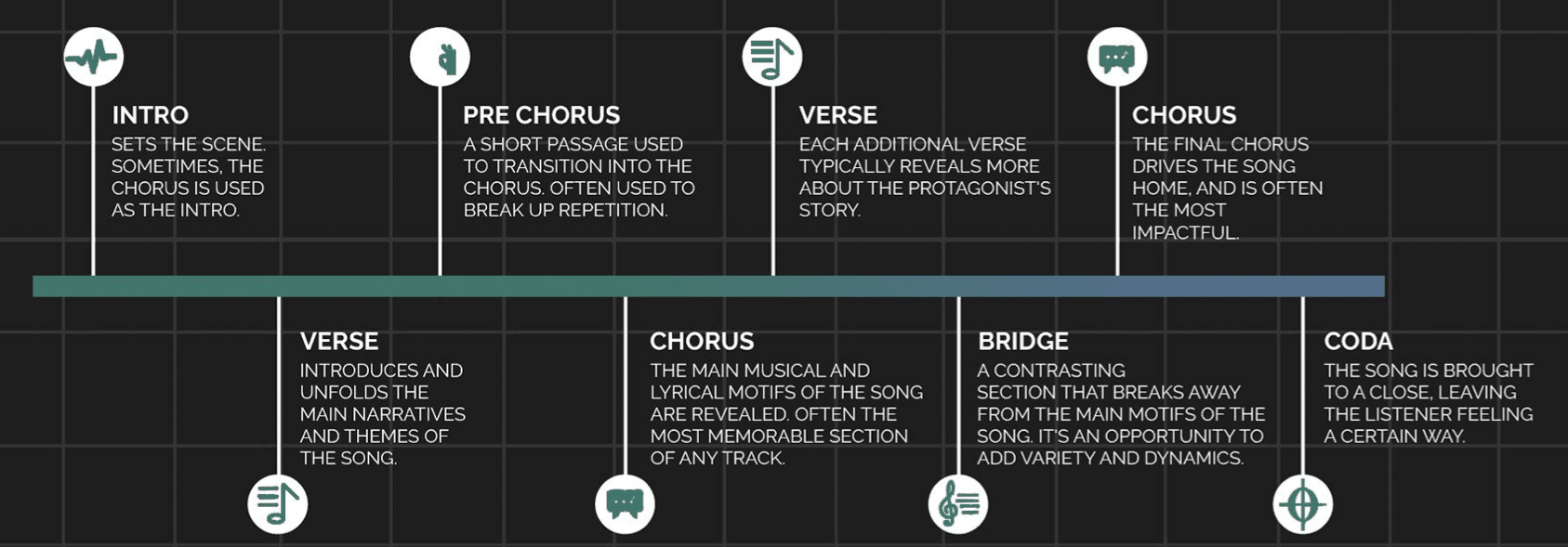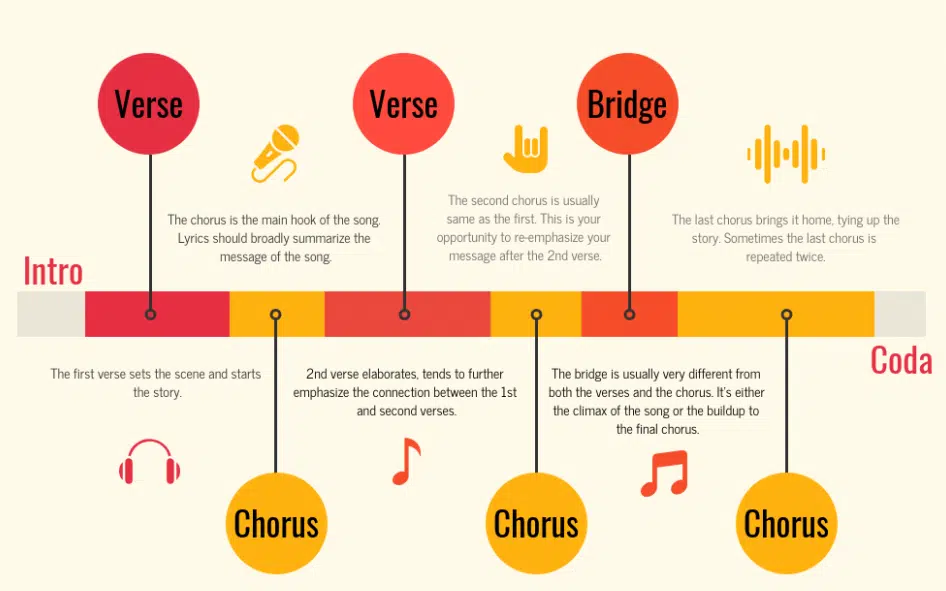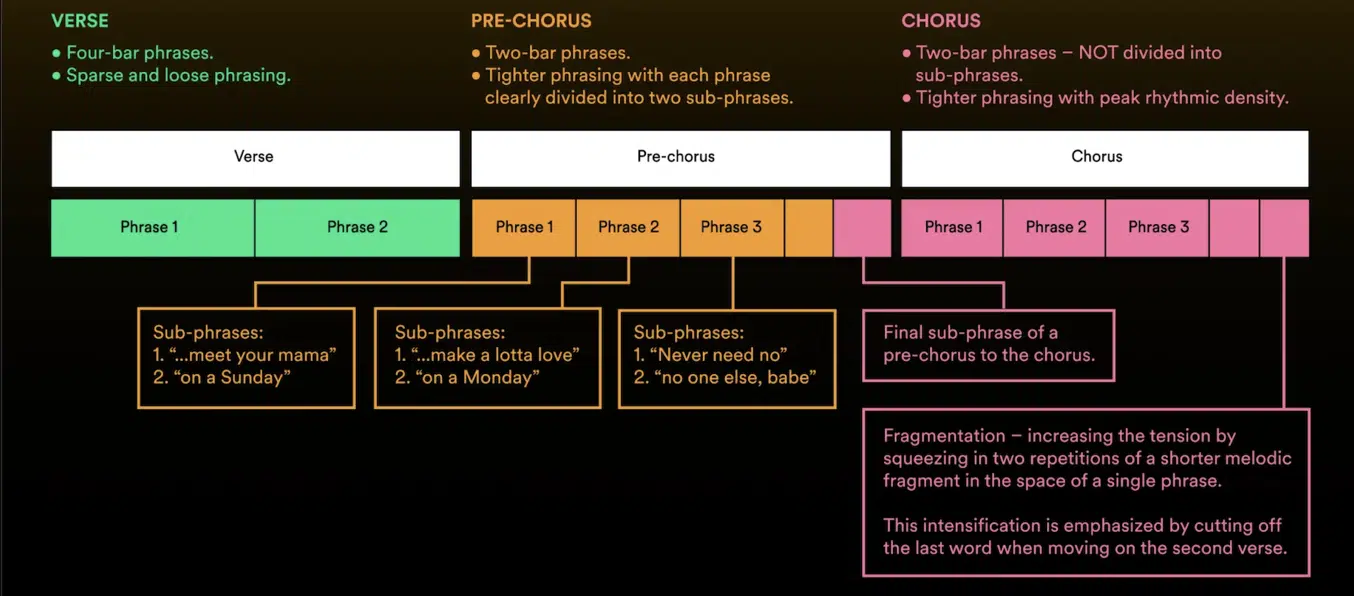Verses are essential components of your song that can set the scene, introduce characters, and develop themes that build up to the song’s chorus.
They offer lyrical depth, creating contrast and dynamic flow within the song.
So, as an artist or music producer, it’s super important to know how to create verses that are impactful and engaging.
In today’s ‘what is a verse in a song’ article, well be breaking down:
- What is a verse in a song ✓
- Understanding basic song structure (like verse-chorus form) ✓
- Elements of a good verse ✓
- Different lyrics, melodies, rhyme schemes, and patterns ✓
- Chord progressions ✓
- Differences between verse and chorus ✓
- Writing professional/effective verses ✓
- The keys to writing hit songs ✓
- Creating the first verse & subsequent verses ✓
- Using pre-chorus and integrating instrumental solos ✓
- Advanced tips for writing verses/lyrics ✓
- The importance of melody and harmony ✓
- Common mistakes in writing verses ✓
- Enhancing your songwriting skills ✓
After reading this article, you’ll be able to successfully answer the question, “What is a verse in a song?”
Plus, you’ll know all about the other key elements of song structure as well, to get the full picture of how most songs are created.
This way, you can create epic songs and produce popular music like a professional.
So, let’s dive in…
Table of Contents
What is a Verse in a Song?

A verse in a song is a section where the story unfolds; often using different lyrics but maintaining the same melody throughout the song.
In most popular music, a verse typically sets the scene and builds the narrative 一 leading into your song’s chorus.
Understanding what is a verse in a song is super important for any artist, music producer or songwriter, as it helps emphasize the song’s main idea.
The verse’s lyrics are super important when it comes to painting a very vivid picture for the listener (so your song’s message gets across).
They also allow for greater lyrical exploration, giving you the freedom to dive deeper into the song’s themes and get people more invested.
Each verse in a song should maintain the listener’s attention by providing fresh, engaging content while staying true to the song’s melody.
NOTE: The balance between repetition and variation is key to keeping the song interesting and engaging.
By understanding the specific role and importance of a song verse, you can enhance your songwriting skills and create more captivating music.
Whether you’re laying down the first verse or a subsequent verse, you have to make sure that each section adds to the vibe while leading smoothly into the chorus.
If you remember these key factors, you’ll never have to ask yourself, ‘what is a verse in a song?’ again.
Understanding Basic Song Song Structure

In most songs, the basic song structure follows a more predictable pattern that helps create a sense of familiarity and fluidity.
These little details are what people love and remember in the long run.
A common structure is the verse-chorus-verse-chorus format, where the song alternates between verses and choruses.
This musical structure uses repetition to make the song memorable, with the chorus serving as the main hook that is repeated several times.
As we said, the verses provide a detailed narrative and context 一 setting things up for the impactful chorus.
Understanding this basic song structure is essential for any artist or music producer, as it forms the foundation for many popular songs.
Another popular music structure is the ABABCB format, which includes:
- Verses
- Choruses
- A bridge
It adds a bridge section after the second chorus; introducing a new musical idea or theme that contrasts with the verses and choruses.
The bridge provides a refreshing change, often leading to a final chorus that brings the song to a satisfying conclusion.
By mastering these basic song structures, you can create songs that are both engaging and easy to follow, keeping the listener’s attention throughout.
-
Verse-chorus-verse-chorus-bridge-chorus (ABABCB)

The ABABCB structure (verse-chorus-verse-chorus-bridge-chorus format), is widely used in popular music of all genres and styles.
It features:
- Two verse
- Two choruses
- The bridge
- A final chorus
The verses establish the song’s narrative, while the choruses deliver the song’s main message or hook that people remember long after the song ends.
The bridge on the other hand introduces a unique new musical element 一 providing contrast/tension and preventing the song from becoming boring.
This musical structure helps maintain the listener’s interest by adding variety and creating a sense of progression within the song.
Basically, the ABABCB structure will give you a dynamic and engaging song format.
NOTE: The bridge section often serves as a turning point in the song; offering a new perspective or a shift in lyrical content.
This variation keeps the listener engaged and enhances the overall impact of the song.
By understanding and utilizing this structure, you can knock out songs that are both memorable and interesting, using the full power of each section’s unique role.
-
Other Popular Song Structures

Apart from the ABABCB structure, there are other popular song structures that musicians frequently use.
One such structure is the AABA form, commonly found in jazz and early pop music.
This form consists of:
- Two initial song sections (A)
- A contrasting bridge (B)
- A return to the initial section (A)
This structure creates a sense of return and familiarity, which can be very satisfying for listeners (they almost expect it).
Understanding various song structures will help you choose the absolute best format for your unique musical ideas.
Another commonly used structure is the verse-chorus-bridge form… it includes multiple verses, each followed by a chorus, and a bridge section.
As always, the verses provide the narrative, the choruses reinforce the main theme, and the bridge introduces a contrasting idea.
This structure is flexible and also ideal for most popular genres and styles.
The 12-bar blues is also a classic song structure (particularly in blues and rock music), consisting of a repeated 12-bar chord progression; typically using three chords.
It’s simple yet effective 一 providing a solid foundation for improv and variation.
Knowing these structures helps you create many songs that are innovative yet also grounded in musical tradition.
By mastering different song structures, you can enhance your songwriting skills and create more engaging music.
Elements of a Good Verse
Your song’s verse should combine engaging lyrics and a compelling melody to get people hooked. It supports the song’s main idea and sets things up for the chorus. Let’s break it down so you can really understand.
-
Lyrics and Melody

Different lyrics of a verse are key when it comes to musical storytelling.
They are going to provide the details, mood, and context that really make your listeners emotionally invested (and not just skip straight to the chorus).
Remember, it’s all about building the narrative in a unique and creative way.
Your song’s verse should:
- Convey emotions
- Set the scene
- Create a twist
- Introduce characters or themes
It’s important to really paint a picture to create a strong connection with your audience; one that they’ll relate to and want to hear over and over again.
By writing meaningful lyrics, you can make your multiple verses more impactful.
Melody plays an equally important role in a verse…
A catchy and memorable melody helps to hold the listener’s attention and creates a cohesive musical experience.
The melody should go with the lyrics perfectly and enhance the overall mood of the song without one element overpowering the other.
Make sure to play around with different melodies, because a strong new melody can make your one verse (first-last verse) stand out and leave a lasting impression.
It can be make-or-break, essentially.
-
Rhyme Schemes and Patterns (Song Verse)

Rhyme schemes are essential for creating a sense of rhythm and flow in your verses.
Common rhyme schemes include:
- AABB
- ABAB
- ABCB
A repetitive pattern like this will help you create a cohesive and structured feel 一 making the lyrics easier to remember and sing along to.
However, experimenting with different rhyme schemes can add variety and interest to your verses.
Using rhyme schemes creatively can elevate your songwriting and make your verses more engaging and alluring.
In addition to rhyme schemes, the rhythm and meter of your lyrics are important; onsistent rhythmic patterns help to establish a groove and make the lyrics pop.
Varying the rhythm can add interest and prevent the verse from sounding monotonous.
Make sure to pay attention to the natural cadence of your words and how they fit with the same melody because it should have a real natural flow.
Pro Tip: Shorter verses can create a sense of urgency and keep the listener’s attention, while longer verses allow for more detailed storytelling/deeper emotions.
Choosing between shorter verses and longer verses depends on the overall vibe of your song and the beat that’s behind it.
-
Chord Progression Essentials

Chord progressions are the backbone of your song’s same harmonic structure, providing the foundation for the melody and set the mood for the verse.
Common chord progressions in pop music/modern music include I-IV-V, ii-V-I, and I-vi-IV-V.
These chord progressions create a sense of movement, intrigue, and resolution.
Experimenting with different chord progressions can help you find the perfect new harmonic pattern for your verse.
A good chord progression should support the melody and enhance the emotional impact of the lyrics, so it’s important to choose chords that:
- Complement the lyrical content
- Create the desired mood
For example, a major chord progression conveys happiness, brightness, and an overall good vibe.
The same chord progression played in minor, on the other hand, can create a sense of sadness or tension.
By understanding how different chords affect the mood, you can knock out a verse that is emotionally captivating (therefore, it’ll stick in their heads).
Verse vs. Chorus: Breaking it Down

Both the verse and chorus serve different (but complementary) roles in your song, so understanding their differences is key to writing effective and engaging music.
The primary difference between verses and choruses lies in their function and content.
- Verses provide the detailed narrative and context of the song, often changing lyrics with each repetition.
- Choruses, on the other hand, contain the central message or hook of the song, usually with repeated lyrics and melody.
This repetition makes the chorus section more memorable and catchy, like most popular songs.
By alternating between verses and choruses, you create a dynamic and engaging song structure that is balanced.
Another key difference is the musical arrangement…
Choruses often have a fuller and more intense arrangement compared to verses, highlighting the chorus and making it stand out.
The verses build up to the chorus, creating anticipation and release.
Understanding these key differences allows you to use verses and choruses expertly to enhance your song’s overall impact.
Writing Professional/Effective Verses
Writing show-stopping verses requires a blend of creativity and technical skill. The following, are some tips for creating intriguing verses that enhance your full song.
-
Creating the First Verse

The first verse is super important as it sets the tone and context for the entire song, reeling people in (remember, first impressions are everything).
To create an impactful first verse, start with a strong opening line that immediately grabs the listener’s attention.
Always use vivid imagery and specific details to paint a picture, drawing the listener into the main story.
For example, try describing:
- A specific scene
- A relatable feeling
- An event that relates to the song’s main idea
It will help establish a clear scene and mood 一 laying the groundwork for the song’s chorus and overall theme.
Additionally, the first verse should introduce the song’s main idea and lyrical vibe.
Consider using storytelling techniques like introducing a character or setting up a situation that will be explored further in the song.
Always throw in some metaphors, or symbolic language to add depth to your song’s lyrics, making it Tik-Tok worthy, so to speak.
This strategy helps create an interesting narrative that engages the listener from the start and sets up the chorus section effectively.
-
Developing Subsequent Verses

Subsequent verses should build on the foundation laid by the first verse, further developing the song’s narrative and emotional depth.
Each new verse can introduce:
- Additional details
- New perspectives
- Progress the storyline
For instance, you might add more background to the characters introduced in the first verse or explore different aspects of the main theme.
This helps keep the song interesting and engaging 一 providing a sense of progression and development with the same music.
It’s all about driving the song forward in a cohesive, natural way.
Maintaining a consistent melody across all verses is important to create a cohesive musical experience.
While the song’s lyrics may change, keeping the melody similar helps establish a recognizable/basic song pattern that people can cling to.
You might experiment with slight variations in the melody or rhythm to add interest without losing the overall coherence.
This balance between lyrical variation and melodic consistency ensures that each verse enhances the song’s impact.
Remember, listening to excellent verse examples can really help inspire and guide you.
-
Using Pre-Chorus Like a Boss

A pre-chorus is essentially a transitional bridge between both the verse and the chorus, building anticipation and adding dynamic contrast.
This section (pre-chorus) can introduce a slight change in melody or rhythm to create a sense of tension before the chorus hits.
For instance, you might use ascending melodies or increasing intensity in the instrumentation to build up the energy.
This same pre-chorus/melody technique can make the transition to the great chorus more powerful, impactful, and engaging.
The pre-chorus can also offer a song-lyric shift that sets up the chorus thematically.
It’s an opportunity to emphasize key elements of the song’s message or introduce a new idea that will be expanded in the chorus.
By using a pre-chorus correctly, you can heighten the listener’s anticipation and make the chorus more satisfying; which is what it’s all about.
-
Integrating Instrumental Solos

Instrumental solos can add a unique and engaging element to your song, providing a break from the vocal sections.
An instrumental solo can showcase musical talent and add a new texture to the song, so you can try using a:
- Guitar solo
- Piano riff
- Synth lead
This will create much-needed variety and interest.
This can provide a refreshing contrast to the verses and choruses 一 enhancing the overall dynamics and harmonics of your song.
Incorporating instrumental solos strategically can also emphasize certain parts of the song that need to shine.
For example, placing a solo after the second chorus can add a climactic moment before returning to the final chorus.
This will help maintain the listener’s interest and add a layer of complexity to the song structure that people will appreciate.
Advanced Tips for Writing Verses/Lyrics

Writing advanced verses tend to trip some people up because it involves experimenting with different lyrical techniques and musical elements.
However, if you really stay focused and put your mind to it, it’s not that hard.
One approach is to use internal rhymes and alliteration to add a poetic quality to your song’s lyrics, as well as manipulate the phrasing and rhythm.
Another technique is to incorporate unexpected i chord changes or melodic twists to keep the listener engaged.
By pushing the boundaries of your song’s verse and the style in which you write, you can create unique and memorable songs like the pros.
It doesn’t only help push the song forward, but gives people a reason to stay invested.
Another advanced tip is to pay attention to the arrangement and production of your verses; tweaking certain parts that are lacking and emphasizing others.
NOTE: Layering different instruments or vocal harmonies can also add extra depth and texture to your verses.
You might also experiment with different recording techniques or effects to create a distinct sound.
These advanced techniques can help your verses stand out and contribute to the overall impact of the song and help you understand what is a verse in a song much better.
Common Mistakes in Writing Verses

One common mistake in writing verses is relying too heavily on clichés or predictable phrases that people have said a million times before.
This can make your song’s lyrics sound unoriginal and uninspired, so try using fresh and creative language that adds depth and interest to your verses.
Another mistake is neglecting the melody in favor of focusing solely on the lyrics.
A strong melody is essential for making your verses memorable and engaging, so be sure to give it the attention it deserves.
Another pitfall (that not all songs take into consideration) is not paying enough attention to the song’s overall structure… this can be super destructive.
Your song verse should flow naturally into the chorus and other sections, creating a cohesive musical experience.
Also, avoid abrupt transitions or disjointed sections that can disrupt the song’s flow.
By swerving these common mistakes, you can improve your songwriting skills tenfold and create more effective and polished verses.
What is a Verse in a Song: Final Thoughts
Understanding song structure, including verses, is key for creating engaging and memorable music that people are instantly drawn to.
You need to know how to create each unique section the proper way.
Plus, make sure your song flows naturally and keeps the listener hooked from start to finish (just like the best of them).
After today’s ‘what is a verse in a song’ article, you’ll be able to do so like a boss.
To take your songwriting skills to the next level, make sure to check out the #1 Songwriting Course that breaks down all the songwriting secrets.
You’ll get exclusive access to industry insights that can elevate your songwriting.
It will help you easily create show-stopping melodies, chord progressions, basslines, and even drum patterns that will blow people away.
With 9+ hours of video training, there really is no better course for becoming a professional songwriter, truly.
Now, go write those hit songs and never worry about asking, “What is a verse in a song?” again.
Until next time…







Leave a Reply
You must belogged in to post a comment.